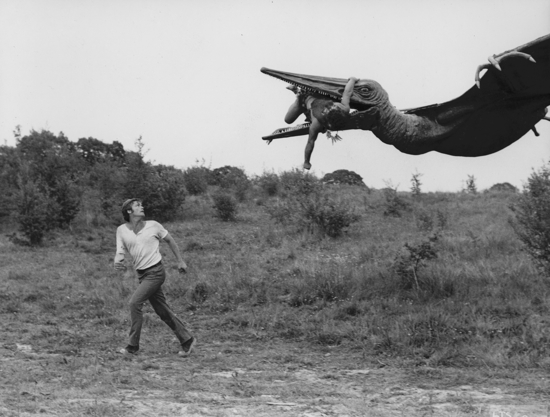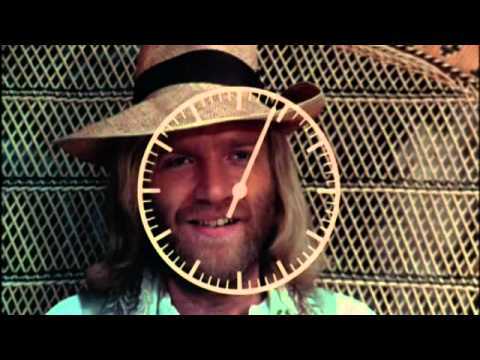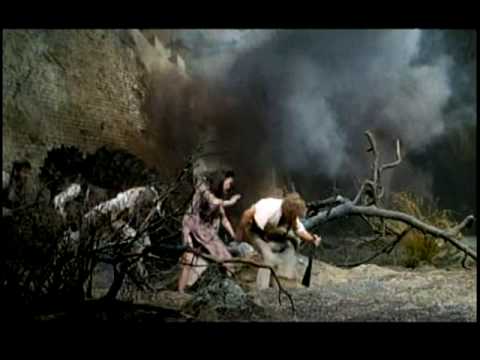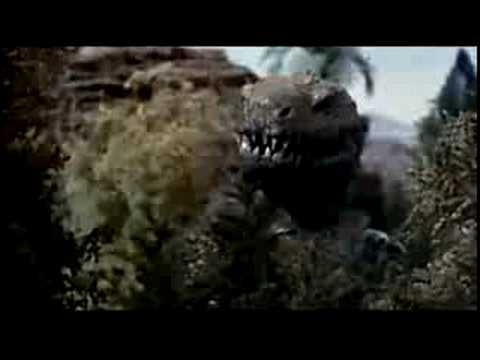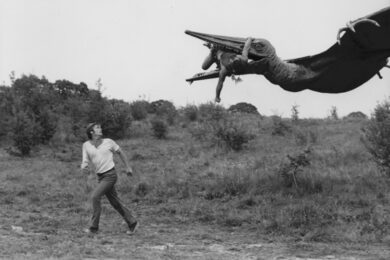You may not remember Doug McClure from a whole slew of American B movie westerns, TV shows and beer commercials. However if you’re British and aged 30 or over you almost certainly will remember him from a handful of period films, involving men in waistcoats battling poorly realised dinosaurs and other beasties, that were mainstays of Saturday and Sunday afternoon television throughout the 1980s and early ’90s. Despite having an extensive career in film and TV in the United States, as demonstrated by his star on the Hollywood Walk of Fame, it was these low-budget British flicks, products of second tier studio Amicus, which burned McClure into the minds of UK audiences.
Like fellow studio Tigon, Amicus Productions successfully forged a niche in the British film industry producing thrillers and horrors throughout the ’60s while living in the shadow of the mighty Hammer. The most memorable example of Amicus’s output, and a specialty of the studio, was a series of horror anthologies known as portmanteaus that exploited the formula established by the classic Ealing production Dead Of Night (1945): an overarching narrative bookends a short series of seemingly unconnected episodes featuring high profile British, and later American, character actors experiencing spooky or otherwise terrifying goings-on, finally revealing a suitably gratifying twist.
The most successful of the Amicus films are often mistakenly attributed to the more famous Hammer studio thanks, in spite of comparatively tighter purse strings, to high quality production values and the ability to attract recognisable casts and established directors such as Freddie Francis.
Although they undoubtedly beat the portmanteau horse to death after the success in 1964 of their first effort, Dr Terror’s House Of Horrors, studio owners Milton Subotsky and Max Rosenberg were nevertheless prepared to gamble on innovations. Early in the decade they obtained the rights to produce two colourful adaptations of the Doctor Who television stories, namely Dr Who And The Daleks (1965) and Daleks – Invasion Earth: 2150 AD (1966). On the horror front the partners were similarly not afraid to attempt to break new ground, most notably in The Beast Must Die (1974), a whodunit featuring a gimmick called The Werewolf Break. During this short interval the audience are invited to reflect upon the film so far and form a judgement as to which character has been transforming into a rather playful German Shepherd. Spoiler: It’s not the hairy dude.
In the mid-’70s Amicus embarked upon a short series of Edgar Rice Burroughs adaptations that would prove to be their swansong as a studio before the British film industry, Hammer included, closed up shop in the face of the new wave of American cinema, science fiction and horror movies in particular. The first was The Land That Time Forgot, Burroughs’ tale of the survivors of a U-boat attack in World War One who turn the tables on their antagonists by hijacking the submarine. Following a tense stand-off and some shenanigans between the German crew and our heroes, the U-boat arrives at a mysterious island, populated by prehistoric beasts and primitive tribes, where the laws of nature are subverted. Adventure ensues. The Land That Time Forgot was a milestone in British adventure cinema for a few reasons, not least of which was that for the first time homegrown pictures were visibly starting to creak under the strain of competition from across the Atlantic. 1975 was the year of Jaws.
Edgar Rice Burroughs stories had been sources for cinematic adaptation for almost sixty years but almost every product (in excess of fifty features worldwide by 1975) was Tarzan related. Amicus’s film was the first major attempt to capture something other than the exploits of the loincloth-clad, hollering jungle VIP whom by this time had departed markedly in character from the source material. It was also the company’s first venture involving Doug McClure. So successful was this collaboration that he would appear in three more Amicus movies, two being further ERB adaptations. In At The Earth’s Core (1976), McClure provides the beef to Peter Cushing’s bumbling Dr Perry in the weakest of the four Amicus adventure outings due to its confined studio setting, subpar monsters and Cushing’s woeful over-egging of his role.
The People That Time Forgot (1977) was a direct sequel to The Land… that explained the fate of the survivors of the first film as, Beneath The Planet Of The Apes-style, the story unfolds from the perspective of an attempted rescue mission that falls prey to a similar fate before McClure makes a late appearance to wrap up proceedings. Unfortunately it lacks most of the qualities that made the first instalment a success and star Patrick Wayne (son of John) is a poor stand-in for McClure, but it does feature a welcome role for genre starlet Sarah Douglas.
The fourth, final and only non-ERB based Amicus/McClure monster mash-up was nevertheless heavily influenced by Burroughs. In Warlords Of Atlantis (1978) a turn of the 20th century expedition in a diving bell leads McClure and his companions to be dragged into the depths by a giant octopus and emerge on the shores of lost Atlantis. Put to slavery by the advanced Atlanteans they battle giant beasts (naturally), lead an uprising and escape, only to face treachery from within their own ranks.
Warlords Of Atlantis bears favourable similarities to The Land That Time Forgot and in some ways exceeds it. The monsters, while evidently primitive by today’s standards, still convince to some degree by virtue of good model and miniature work, plus truly remarkable rear projection techniques that quality-wise bear comparison to some of the most impressive practical effects accomplished by Studio Toho in the best of their Godzilla flicks, such as the still impressive giant mantis sequences in Ebirah, Horror of the Deep (aka Godzilla Versus The Sea Monster, 1966).
In addition, the skilled production shooting aboard a real ship in the case of Warlords…, and a tremendously effective studio set construct of the claustrophobic confines of a U-Boat in The Land…, lend the early passages of both films a solid sense of grounding and reality before the rubber monsters are unleashed. Once they are then the decent casts sell the awe and spectacle appropriately, and the artisanal scripts keep the stories flowing at a pace brisk enough to keep the viewer from poking holes in the paper-thin science. Of course, the latter was always less of a problem when adventure films were almost always period-set and audiences were less prone to the sneering criticism common to today’s cinematic efforts (see the most recent Edgar Rice Burroughs adaptation, John Carter Of Mars).
Warlords Of Atlantis was penned by a stalwart of British television, Brian Hayles. Hayles wrote extensively for not only Doctor Who but also Doomwatch, Z-Cars and the long-running radio serial The Archers. In contrast, The Land That Time Forgot was the first, and to date only, filmed screenplay written by the legendary British fantasist Michael Moorcock. Following the release of Robert Fuest’s suitably wacky but sadly unfaithful adaptation of Moorcock’s seminal novel The Final Programme in 1973, Moorcock was distraught and decided, in conjunction with long-time friend and collaborator James Cawthorn, to get involved in the filmmaking process. Moorcock was at the height of his creative powers. Already a recipient of the Nebula Award for Behold The Man, as well as numerous other accolades, he was turning out best-selling fantasy at an almost industrial rate.
An Edgar Rice Burroughs adaptation was a natural fit for Moorcock. Although he was responsible for the subversion of numerous fantasy tropes throughout the ’60s, he was inspired enormously by Burroughs’ John Carter books as a child, Gods Of Mars in particular. In fact his earliest series, the Kane Of Old Mars trilogy, was a shameless John Carter pastiche penned under the pseudonym Edward P Bradbury. Moorcock was hired, and given the authority by Edgar Rice Burroughs Inc, to write a faithful adaptation of the source novel. Unfortunately the lack of budget on the monster front and the wishes of the producers to insert genre staples like volcanoes left Moorcock somewhat dissatisfied with the result. He and Cawthorn withdrew from involvement in the sequel due to further intended departures from the source material, and the obvious problems inherent in filming pterodactyl versus biplane fights on a limited budget.
Despite Moorcock’s criticisms of the hand puppet nature of the monsters and the ‘everything explodes’ finale, The Land That Time Forgot is more than a nostalgic trip down memory lane, it’s an all-round fun time. The sheer likeability and seasoned action chops of star Doug McClure play off nicely against a British cast that includes a young Susan Penhaligon and pre-The Master Anthony Ainley as the obligatory nasty German. The splendid visual juxtaposition of U-boat versus dinosaur combines with the accomplished model and miniature work (bad pterodactyl aside), not to mention the plot’s shameless ambition, to make the film substantially more than the sum of its now decidedly bargain basement parts. For those who remember a time before computers, low-budget dinosaurs did look like rubber hand puppets, or lizards with fans glued to their backs, and there may still be a small part of these viewers’ minds within which the high tech renderings of Jurassic Park and Walking With Dinosaurs are rejected as utterly fake and the worst kind of cynical, revisionist history.
Four digitally restored Amicus titles – The Land That Time Forgot, At The Earth’s Core, Warlords Of Atlantis plus Freddie Francis’ 1967 science fiction They Came From Beyond Space – are out now on DVD via StudioCanal.

